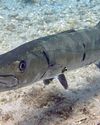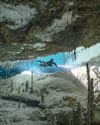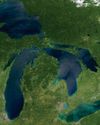
MANTA RAY
ESA Threatened CITES Appendix II
Using pectoral fins spreading up to 23 feet (7m) across, giant manta rays glide like underwater spaceships. Mantas have one of the largest brain-to-body size ratios in the marine world and appear to recognize themselves in mirrors, according to several studies. These animals also seem to recognize other individuals and to have preferred relationships maintained over time. Divers have observed these animals playing in their bubbles.
NOAA surveys show that manta rays are most common off northeastern Florida during April, moving north as temperatures warm to the North Carolina coast and south in the fall to the Georgia coast. In the Gulf of Mexico, they hang around the Mississippi River delta from April to June and October to November.
Individual mantas can be identified by the unique patterns on their undersides, and scientists use this fact to monitor specific populations. Staff at the Flower Garden Banks National Marine Sanctuary in the Gulf of Mexico have created a photo catalog of individuals seen there. A manta photo catalog created by biologists at Australia’s Ningaloo Reef revealed that scars originally thought to be created by predators were probably from vessel strikes. The animals bask and feed at the surface, and boat strikes are an increasing threat.
Their main threat globally is directed take for their gill rakers, used in traditional Chinese medicine, and indirect take by industrial fisheries, says Nick Farmer with NOAA Fisheries Southeast Office of Protected Resources Division. They also are affected by bycatch, entanglement, and pollution. A nursery habitat in the heavily urbanized waters off the Florida coast raises particular concern about plastics and other pollution.
This story is from the Spring 2023 edition of DIVER Canada.
Start your 7-day Magzter GOLD free trial to access thousands of curated premium stories, and 9,000+ magazines and newspapers.
Already a subscriber ? Sign In
This story is from the Spring 2023 edition of DIVER Canada.
Start your 7-day Magzter GOLD free trial to access thousands of curated premium stories, and 9,000+ magazines and newspapers.
Already a subscriber? Sign In

Fun With a Smart Phone
Compact digital cameras are fast disappearing in favour of smartphones. How about underwater photography?

An Old Encounter
The mighty St. Lawrence River, in its Quebec section, has swallowed hundreds of wrecks through the centuries, many of them still unvisited.

Al is Coming to Diving
You are about to enter another dimension—a scuba dimension not only of sight and sound, but of mind. A journey into a wondrous land of imagination. Next stop…no, not the Twilight Zone…but the AI Zone! Yes, Artificial Intelligence is coming to scuba diving.

Preventing heat exhaustion
Beautiful sunny days have a way of coaxing us outside for adventuring, exploring, and diving. But it’s important to be mindful during your outdoor activities of the risks of heat-related illnesses— especially in the summer.

You Won't Impress Your Cave Instructor
I am so sorry for disappointing you!” My student apologized as he tossed his cave diving light into the gear crate and dropped his fins beside my truck.

THE PERFECT STORM
WORDS AND PHOTOS BY NICOLE WEBSTER

PROTECTING NAYAANO NIBIIMAANG GICHIGAMIIN
The Great Lakes Watershed

Phil Nuytten: DIVER
Industry luninaries remember diving legend Phil Nuytten, OC, OBC, DSc (hon), LLD (hon): magazine publisher, engineer, innovator, artist, businessman, eccentric, raconteur, magician, writer, husband, father... and-first and foremost-diver. (1941-2023)

Phil Nuytten - SIMON FRASER UNIVERSITY CONVOCATION ADDRESS
A final Soundings column from DIVER Publisher and Senior Editor Phil Nuytten, taken from his 1995 address to students in British Columbia

NEW DEEP CAVE DIVING RECORD SET IN CHINA
Renowned Chinese cave diver Han Ting surfaced after a 12-and-a-half-hour dive to 910.1 feet (77.4m) in Jiudun Cave, a new Asia deep cave diving record. The dive was a part of the Duan’s Juidun Cave Features (DJCF) project.